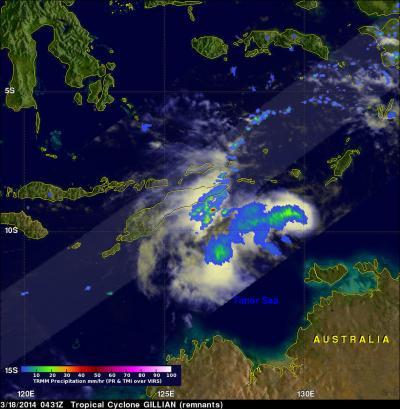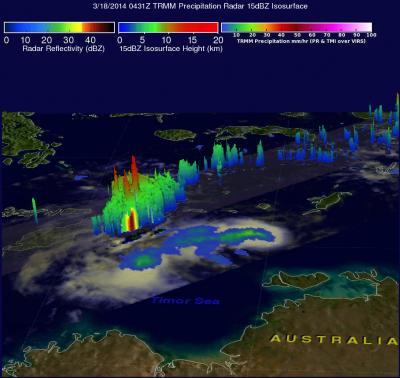NASA's TRMM satellite passed over the remnants of Tropical Cyclone Gillian and spotted some towering thunderstorms and areas of heavy rainfall, indicating there's still power in the former tropical storm.
Over the past few days former tropical cyclone Gillian's remnants moved from the Gulf of Carpentaria into the Timor Sea. The Tropical Rainfall Measuring Mission satellite known as TRMM found a few strong convective thunderstorms when it passed above these remnants on March 18, 2014 at 0431 UTC. TRMM's Precipitation Radar (PR) instrument measured rain falling at a rate of over 86 mm/3.4 inches per hour in some intense storms.
The Joint Typhoon Warning Center or JWTC recently assigned Gillian's remnants a medium chance to regain tropical cyclone status. Asimulated 3-D image was made at NASA's Goddard Space Flight Center in Greenbelt, Md. using TRMM PR data. The 3-D image showed that several of the tallest thunderstorms in Gillian's remnants were reaching heights of over 15.75 km/9.8 miles. Radar reflectivity values of over 50.7 dBZ were being returned to TRMM from the heavy rainfall within these storms.

TRMM passed above Gillian's remnants on Mar. 18, 2014, at 04:31 UTC and measured rain falling at a rate of over 86 mm/3.4 inches per hour in some intense storms.
(Photo Credit: SSAI/NASA, Hal Pierce)
The Australian Bureau of Meteorology issued their last statement on Gillian's remnants on March 18 at 10:45 p.m. CST local time/Darwin. At that time, Ex-Tropical Cyclone Gillian was located 9.6 south latitude and 128.4 east longitude, about 330 km/205.1 miles east southeast of Dili and 525 km/326.2 miles east of Kupang and moving west at 24 kph/38.6 mph.
Gillian's remnants, now in the Southern Indian Ocean basin, are expected to continue moving to the west across the Timor Sea, away from the Northern Territory.

TRMM passed above Gillian's remnants on Mar. 18, 2014, at 04:31 UTC, and this 3-D simulation of TRMM data showed several of the tallest thunderstorms in GILLIAN's remnants were reaching heights of over 15.75 km/9.8 miles.
(Photo Credit: SSAI/NASA, Hal Pierce)
Source: NASA/Goddard Space Flight Center